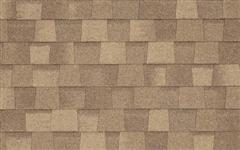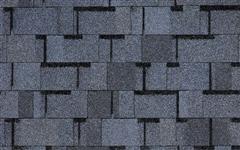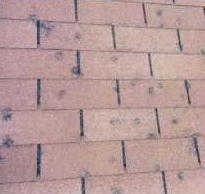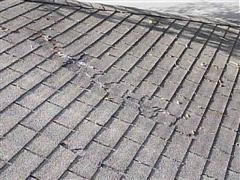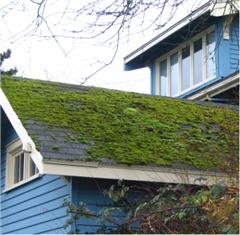(505) 588-9559
SuperHomeInspections@Yahoo.com
Superior Home Inspections
Certified Home Inspectors in Albuquerque, Rio Rancho, New Mexico areas.
|
|
Asphalt ShinglesAsphalt shingles are the most common roof covering that you will see, as they are relatively inexpensive, easy to install, and last between 15 to 40 years, depending on type. Despite the fact that there are many different styles of asphalt shingles, they are all manufactured and installed in the same way, so they tend to exhibit similar problems over their service life. Basic Shingle Construction All these shingles are made from an asphalt-impregnated mat, either of a cellulose material (regular shingles) or fiberglass (fiberglass shingles). The mat is then covered with a heavier layer of asphalt. Finally, a layer of granules is pressed into the surface as protection from ultraviolet light. The quality of asphalt shingles is in direct proportion to their weight per square (100 square feet). Heavier shingles (up to 350 pounds per square) generally last longer than the lighter shingles (200 pounds per square). The heavier shingles tend to be of the architectural style, with several layers of material. You need to be aware that most jurisdictions allow only two layers of shingles to be applied to the roof due to the load considerations. For example, a 15-square area of roof with two layers of average 250-pound shingle has a total weight of covering of 7,500 pounds, or nearly 4 tons of weight. Asphalt Shingle Installation
The under layer for asphalt shingle is usually roofing felt with a course of ice and water shield covering the lowest 3 feet. This prevents moisture from backing up under the shingle over the eaves. The application starts at the bottom of the roof with a single starter course (often, a shingle with the tabs cut off) fixed so that the first proper course is glued at the lowest edge. This is followed by the regular courses applied so that the joints or gaps between the tabs do not line up with each other, and over three courses to stop water penetrating the covering. Each shingle has a tar line above the exposed surface which glues the upper shingle to the previous course. Ridges are capped with either a special tile manufactured for the purpose (as in the case of architectural styles) or, more commonly, trimmed-down shingles prepared on-site by the installer from standard 3-tab shingles. Asphalt shingles are designed to be installed on roofs with a pitch greater than 4/12, but some shingles can be installed on roofs as low as 2/12 where proper precautions, such as double underlayment, have been installed, and the shingles themselves have been additionally glued down in accordance with the manufacturer's instructions.
Asphalt Shingle Designs There are many designs and colors of asphalt shingle available. The basic designs are: 1. standard shingle, with no decorative features; 2. 3-tab shingles which somewhat ape roof tile (shown above); and 3. architectural shingles which have added layers of material to mimic the look of slate or shake roofs. 4. standard shingle, with no decorative features; 5. 3-tab shingles which somewhat ape roof tile (shown above); and 6. architectural shingles which have added layers of material to mimic the look of slate or shake roofs. Asphalt Shingle Problems All asphalt shingle roofs, regardless of design, will fail due to the following reasons: 1. weather issues; 2. impact damage; 3. debris on the roof; 4. poor installation techniques; 5. material failures; 6. ventilation problems. Weather Issues Sunlight is a big enemy of asphalt roofs. When subjected to the sun's heat, the shingles will dry out due to off-gassing of hydrocarbons in the asphalt, since asphalt is a petrochemical product. This will promote the loss of granules and make the shingle more brittle. As the shingle dries out, it will also shrink, opening up the areas between shingles or between tabs. This may also cause cupping, bowing and small surface fractures or fissures in the shingle.
Rainfall will wash away the granules over a period of time, causing the tile to degrade. Traces of aggregate in the gutter signify potential problems. Wind can get under the exposed tabs on the shingle and cause them to be ripped from the roof. Hailstones can easily damage the roof covering, causing small depressions in the shingles, and potentially breaking off weak shingles.
Impact Damage Trees cause the most impact damage, by branches being too close to the roof covering and tree limbs falling onto the roof structure.
Walking on the roof can, in some cases, cause damage to the coverings, especially if they are already in brittle condition. Masonry falling on the roof will often damage tiles. It is not uncommon to see damaged shingles directly below the chimney. Moss is a big problem on badly drained and shady roofs because it retains moisture and its root system will get under the roof shingles. It's fair to say that you will not generally see moss on a good roof, as the roots need to be constantly moist.
Leaves and pine needles on the roof will also promote fast decay of the covering because they retain moisture on the roof. Also, many species produce acids during the decay process, and these can eat into the asphalt. Airborne pollutants are often found in industrial areas. Although not as much of a concern as it once was, "acid rain" will quickly erode a roof covering.
Poor Shingle Installation Here are some of the issues that often occur due to poor installation: repairs that were improperly carried out;
shingles on a low-pitch roof where the use of shingles is not intended; joints were not overlapped, allowing water to drain right onto the sheathing; and nailing was not done to manufacturer's specifications, where either the nails are too short, causing nail pops, or not enough nails were used. Every 3-tab shingle should have four fasteners (or six in high-wind areas). Material Failures You will occasionally see failure due to manufacturing defects, such as blistering from within the shingle, or premature cracking of the shingles, particularly with fiberglass-based shingles. One particular brand of shingle was the subject of a class-action lawsuit against Bird Fiberglass Shingles of New Hampshire, which was settled in 2001
Ventilation Problems Many problems with asphalt shingle roofs are caused by poor ventilation of the roof space, which leads to overheating of the roof coverings. This is more apparent when the roof has multiple coverings which can trap additional heat. It is very common to see shingles that are less than 10 years old but are in very bad shape due to overheating caused by poor ventilation, or too many layers. Since the asphalt shingle is the most common here in Florida, and with our intense sunlight and weather conditions it is extremely important that we know in advance the condition of the roof covering is. When purchasing a home, or listing your home, why not let a professional Home Inspector evaluate it's condition before making that oh so important decision! |






